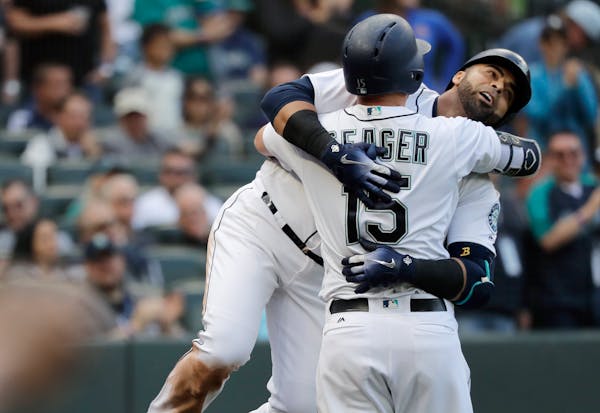The Twins hit 166 home runs last season, fewer than 11 other American League teams. That's hardly unusual. In the Target Field era, they've never ranked in the upper half of the league in homers, a shortcoming that becomes more glaring as the game grows more dependent upon power.
They're working to change that, however, and the signing of Nelson Cruz this week puts an exclamation point on that effort. Adding Cruz and his 37 home runs to the 19 position players already on their roster means the current Twins combined to hit 198 homers in 2018, a total that wouldn't quite boost them into the top half of the AL, but still would represent the fifth-most homers in Twins history.
It's no accident; the Twins' free-agent signings this winter have focused on adding power. C.J. Cron, who hit 30 homers last season for the Rays, was brought in to play first base, and Jonathan Schoop, who managed 21 homers in an otherwise disappointing season for the Orioles and Brewers, will play second. That's a significant power boost for a team with only one other slugger — Eddie Rosario and his 24 homers — who hit more than Schoop.
But Cruz takes this trend to a new level, one that few Twins free-agent signees can boast. Despite having reached his 38th birthday in July, the Dominican DH smashed 37 homers for the Mariners last season, and that total was the fewest he had managed since 2013. A sixth straight season with that sort of production would rank among the greatest ever in Minneapolis, where only Harmon Killebrew (eight times) and Brian Dozier have ever piled up so many long balls.
Twins fans don't have to be reminded, however, that it's dangerous to assume that home runs success elsewhere will automatically transfer to Target Field. Only one free-agent signee in Twins history has ever come aboard off a season with more MLB homers than Cruz's 37: Logan Morrison, who hit 38 for Tampa Bay in 2017. And it was only three winters ago that optimism reigned over the acquisition of a slugger who produced 105 home runs in his two previous seasons: ByungHo Park.
Buyer beware, in other words.
Still, recent fizzles aside, the Twins have a moderately successful history of importing this type of aging-but-still-dangerous hitter. Josh Willingham, signed to a three-year, $21 million contract in mid-December 2011, contributed 35 homers and 110 RBI the next summer, the most productive offensive season (4.7 offensive wins above replacement, as measured by baseball-reference.com) by any Twin but Dozier or Joe Mauer in a decade.
Chili Davis gave the Twins a couple of strong seasons in the middle of their lineup after signing in 1991, a run that included their most recent championship, and Dave Winfield replaced him for two years when Davis moved on. And Jim Thome might be the Twins' most analogous signing to Cruz — the future Hall of Famer was 39 and already owned 564 career homers when he captivated Minnesota by hitting 25 more en route to the Twins' most recent Central Division title.
Thome was an incredible bargain, having accepted a mere $1.5 million to play with the Twins in 2010 after earning at least $11 million in each of the previous seven seasons. Though his $14 million salary is larger, Cruz's signing carries little risk, too. Because the market for full-time designated hitters is so limited — NL teams don't need one, and many AL teams are reluctant to turn the position over to one hitter — Cruz accepted a one-year contract with a team option for 2020.
The deal allows the Twins to preserve their incredible payroll flexibility; Cruz's $300,000 buyout if they don't bring him back for a second season represents the first dollar the Twins have committed to pay to any player beyond next year.
And in addition to the residual optimism that signing one of the game's premier power hitters brings the Twins, a signal that they believe they can close the gap with the first-place Indians, the signing of Cruz might add a new dose of Thome-esque electricity to Twins games. Cruz has hit 10 home runs in Target Field, seventh most of any visitor despite never playing in the AL Central, and one in particular offers a hint of the potential of the player nicknamed "Boomstick."
On Sept. 25, 2016, Cruz crushed a fastball from Tyler Duffey into the third deck above left field, a ball that would have traveled 493 feet, according to MLB's Statcast measurements. That's believed to be the longest home run by a visitor in the stadium's nine-year history (though Statcast data goes back only to 2015).
Phil Miller is a Twins beat writer for the Star Tribune. Email: phil.miller@startribune.com
Former British Open champion Stewart Cink in the hunt at 3M Open
Lively strikes out 6, Guardians top struggling Phillies 3-1 in interleague showdown of MLB's best


